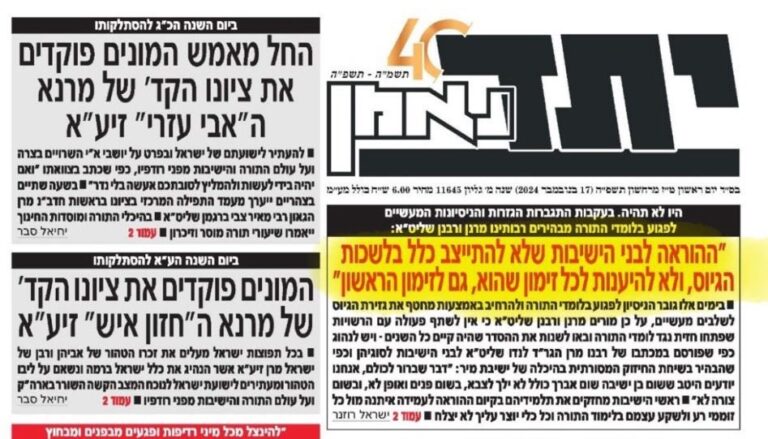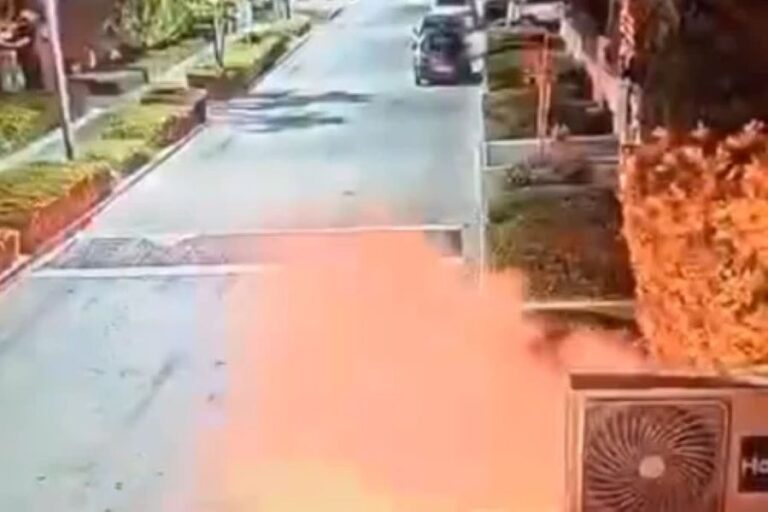 By Rabbi Yair Hoffman for the Five Towns Jewish Towns
By Rabbi Yair Hoffman for the Five Towns Jewish Towns
IT IS FRUSTRATING TO see thoughtlessly and or illegally parked cars. It is also quite maddening to see someone who parks his car so inconsiderately that he is making it difficult for others to get through a narrow crossway or parking lot.
To address this issue, some entrepreneurs have conceived of a sticker that can be placed upon the offender’s windshield or driver’s side window with an extra-strong glue-backing. The stickers take quite some time for the driver to remove. The upshot is that a driver will think twice before parking inconsiderately again.
THE DRIVER IS A THIEF
It must also be noted that parking illegally is technically considered trespassing, which is a form of actual theft.
How do we define trespassing? From the perspective of American law, trespassing is the act of illegally going onto somebody else’s property without permission, which could just be a civil law tort (allowing the owner to sue for damages), or it could be a criminal matter.
What exactly is the halachic violation? The violation is actually that of stealing. The Talmud (Bava Basra 88a) records a debate between Rabbi Yehudah and the Sages as to whether borrowing an item without permission renders a person a gazlan, a thief, or whether he simply has the status of a borrower.
Rabbi Yehudah maintains that he does not have the halachic status of a thief, while the Sages maintain that he does. The Rif and the Rambam both rule in accordance with the Sages-that he is considered a thief. Indeed, this is also the ruling of the Shulchan Aruch in four different places (C.M. 292:1, 308:7, 359:5, 363:5).
Is the “considered a thief” designation applicable in all cases? Generally speaking, borrowing an item has a value associated with it. In the case of trespassing, there may be no particular value per se in setting foot on the person’s property, or in parking improperly. While this may be the case, the Chazon Ish (B.K. 20:5) writes that the prohibition of sho’el shelo mida’as (one who borrows without permission) applies even when the item is not something that generally has a market value, and even if the value is less than that of a perutah.
How do we know that borrowing without permission also applies to being on someone’s land, or parking illegally? Maybe, it can be argued that in order to “borrow,” you have to physically take an object; here, you are just taking up space on someone’s land.
THE PROOF
The Rashbam in Bava Basra 57b discusses a case of a piece of property owned by two partners. The Rashbam writes that we are lenient and assume that one partner allows the other to place his animals on the land even without explicitly giving permission. In such a case, he would not be considered a sho’el shelo mida’as since they, in general, are partners, and would let the other do what he wants with their property. According to the Rashbam, therefore, when not dealing with two partners of a property, trespassing would be subsumed under the concept of sho’el shelo mida’as. Therefore, the one who parks in such a manner is guilty of theft.
So clearly, no one is arguing then that the person has a right to park in that manner. The question is, may we sticker him?
The temptation to sticker an offending automobile is quite great, indeed, almost overwhelming. And, of late, some Shuls have posted signs to that effect – that if anyone is either illegally parked or is blocking or partially blocking access—they will be stickered.
Nonetheless, it seems that it is clearly forbidden.
[The reader should note, by the way, that neither this author, nor any of his family members were ever stickered. This article is strictly an exercise in halachic discovery.]
The Shulchan Aruch (CM 378:1) writes: It is forbidden to damage the property of his friend, and if he does so he must pay full damages. The Sma points out that the Shulchan Aruch mentions both a prohibition as well as a financial obligation to pay in order to highlight that both of these issues are pertinent – it is both a halachic prohibition as well as a financial issue.
The Gemorah (Bava Kamma 48a) discusses a case where a person brought his bull into the private property of another and the owner of that property damaged the bull – the owner is exempt from paying damages. Rav Pappa, however, qualifies it and says that it is only true when the owner damaged the bull without knowing about him. But if he damaged the bull knowing about it the owner of the bull may say, “Granted you have the right to throw me out, but you do not have the right to damage me.”
The statement of Rav Pappa is wholly applicable in our case. The placing of a sticker on the windshield or window is damaging because the glue must be carefully removed and the time that it takes to remove it – is not insignificant. Let us keep in mind that the prohibition to damage another is equal, whether it is smashing his windows and slashing his tires or merely placing a difficult to remove sticker on his window.
SIX POSSIBLE COUNTER ARGUMENTS
1. One might point to the Shulchan Aruch (CM 412:2) where it states, “If someone had filled and placed pitchers across the public thoroughfare in a manner that others cannot pass, even if another broke them with his hands that person is exempt from payment.” The problem is that in the Shulchan Aruch’s case, the breaking of the pitchers serves to allow access. Here, however, the stickering of the car does not help anyone get through. So it is tantamount to just plain damaging or vandalizing.
2. One might also make the argument based upon the Gemorah in Bava Kamma (28a) that a messenger of a Beis Din is even permitted to damage if there is no other way to save an item (See Sma 8:25). But again, the stickering does not help the situation now and, secondly, the shul officers are not a Beis Din.
3. What about the shul acting in a capacity to enforce halacha? There is a debate between the Nesivus and the Ktzos HaChoshen (CM Chapter 3) in regard to whether individuals can take upon themselves to stop someone from doing something wrong. The Nesivus is of the opinion that individuals do have this “Citizen’s Arrest” type of power. The Ktzos HaChoshen, however, writes that this power is unique to Beis Din, and the halacha is in accordance with the Ktzos.
4. A fourth argument can be made that if a warning sign is placed on the parking lot, then when one parks there he is tacitly agreeing to allow himself to be damaged. The assumption is that he certainly does not wish to be considered a thief, therefore, he is an agreement that he may be stickered. The counter to this argument is that he may respond, “I never agreed to submit to this damage. I had thought that what I was doing was not so nice, but not theft.” If so, we do not have any indication that the driver was amenable to be stickered and it would still constitute damaging him.
5. Perhaps there is another angle. There is a halachic tool called an Anan Sahadi which literally means “the entire world testifies.” The Anan Sahadi is not a tool of little consequence. In theory, one can argue that there may be a legal form of acquiescence here.
How so? One could perhaps make an argument that there is an Anan Sahadi that a person would rather be stickered than be towed, and, therefore, there should not be a prohibition in stickering their car. The counter to this is that, when dealing with a shul, the person parking is expecting that the shul administration will perhaps be upset, but they will not tow him. The Anan Sahadi, therefore, does not really exist.
6. There is one last attempt. If we look at the driver as not just someone who is damaging now, but someone who does so continuously, then perhaps we can utilize the principle of Rav Nachman (Bava Kamma 27b) entitled, “Avid Inesh Dina d’nafshai” that a person is allowed to take action outside of court in order to prevent himself from sustaining damage. However, it is clear that the parameters of “Avid Inesh Dina d’nafshai” that a person is allowed to take action outside of court is only in terms of taking back his own item but not in causing someone damage. The Sfas Emes (Brachos 5b) states this specifically.
MORE THAN HALACHA
Stickering a car may also be illegal in New York State.
When a person destroys or damages property illegally it is not called Vandalism – in New York State it is called “Criminal Mischief.” There are four levels of Criminal Mischief in New York State. They range from the lowest level, Criminal Mischief in the 4th degree, which is a misdemeanor to Criminal Mischief in the 1st Degree, a felony.
The lowest level covers any destruction of property for vandalism with a value up to two hundred and fifty dollars. It is a separate criminal charge if someone is caught with possession of graffiti tool. The question whether the sticker is considered a graffiti tool or not would be what the judge would decide. Regardless, this is a misdemeanor and is punishable by up to one year in jail with the possibility of probation, community service and fines.
The next level of criminal mischief is Criminal Mischief in the 3rd degree, a felony. The violator faces a minimum of a year and a day in prison. This covers destruction of property of over two hundred and fifty dollars and up to fifteen hundred dollars.
Criminal Mischief in the second degree is damage to property over $1500.00 and is a Class D felony.
The final level of Criminal mischief is Criminal mischief in the 1st degree which is a Class B felony. This occurs when property is destroyed by use of explosive. Hopefully, shul officers are not so angered that they would resort to this level of a deterence.
LAST ISSUE
There is one final issue. Depending upon the intention of the stickerer, he could very well be violating a Torah prohibition of seeking revenge (See Rambam Hilchos Deyos 7:7). What would be the halacha if he has two intentions – one of revenge and the other of trying to prevent further parking abuse? The Mishna Brurah 38:24 cites a Magen Avrohom about a person’s double intention when performing a Mitzvah, and states that it generally follows one’s main intent.
The reader should know, however, that there aresome Rabbis who disagree with the position presented here and have adopted one of the six rationales expressed above. Each shul should follow the ruling of their Rav in this matter, however, this author consulted with two major Poskim who agreed with the positions set forth above. One of them was unsure, however, about the counter to explanation #4 above.
So what should and could be done? A note should be left on the car explaining that it is wrong and that the license plate was noted, and next time a tow truck may be called. If the car is blocking access, towing would be permitted according to the Shulchan Aruch. (CM412:1). According to what was discussed above, however, stickering would not be permitted.
The author can be reached at [email protected]











7 Responses
The picture in the article is a sticker placed on a car by the Department of Sanitation. I think the use of that picture on an article about PRIVATE individuals “stickering” a car is misleading.
I think the “asur” against stickering is a one time bye…..after the first warning, it should be appropriate to cause some misery to the selfish driver, whether he/she is picking up something at the dry cleaner or running into the beis medrash for a quick mincha…repeated infractions should not be tolerated either under civil law or halacha.
“The placing of a sticker on the windshield or window is damaging because the glue must be carefully removed and the time that it takes to remove it – is not insignificant.”
Is this the halachic definition of damage? Wasting someone’s time?
Rabbi Hoffman Shlita does not deal with the main issue his thesis presupposes: that stickering is causing physical damage to property. These stickers do not do that. They do not cause damage to window glass or even paintwork. The glue simply takes a very long time to remove. Time in which the culprit can consider his selfishness and how v’ahavta lereicha komocha is a serious mitzva. Am Yisrael is great at organising communal chessed projects and help organizations but when it comes to one on one, things get a little ropey, especially if I double park just to run to pick up my wife’s Shabbos sheitel for the simcha tonight or block another yid’s driveway only to jump out and buy some rugelach for the heiliger kinder who have just finished a hard day at cheider. It really isn’t my fault that the line was so long and anyway the guy shouldn’t have left it to the last minute to leave for mincha. Gee I’m sorry he missed his minyan but I really can’t be blamed.
To Rabbi Yair Hoffman:
Keep up the good work. Your articles are very inspiring and thought provoking.
Rabbi Hoffman’s article is very nice as a halachic examination however it should be clear to any caring Yid that v’ahavta lereicha komocha should be a top priority. That means not parking in a selfish inconsiderate way whether or not it is a civil tort or halachically permitted based on Rav Yehuda or ruled assur by the Shulchan Oruch. Sometimes it is possible to lose sight of what is simple right and wrong. Being inconsiderate is wrong. Warning someone not to be inconsiderate, i.e. stickering his car, is actually doing him a favor.
Wrong, the “stickering” of the car DOES help anyone get through. The perp will think twice before blocking other peoples’s access, hence letting people through in the future. As far as “seeking revenge” the RAMBAM permits revenge where no money is involved and 1 is personally hurt or damaged. According to the RAMBAM revenge is only assur where the damage is only monetary.